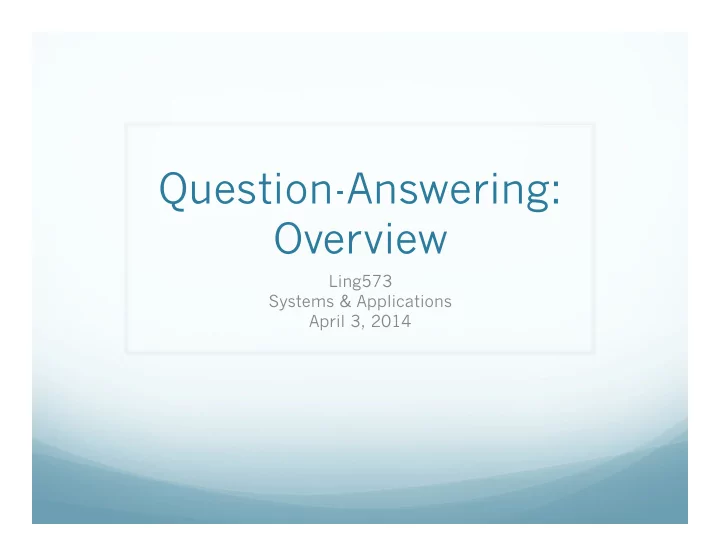

Question-Answering: Overview Ling573 Systems & Applications April 3, 2014
Roadmap Dimensions of the problem A (very) brief history Architecture of a QA system QA and resources Evaluation Challenges Logistics Check-in
Dimensions of QA Basic structure: Question analysis Answer search Answer selection and presentation Rich problem domain: Tasks vary on Applications Users Question types Answer types Evaluation Presentation
Applications Applications vary by: Answer sources Structured: e.g., database fields Semi-structured: e.g., database with comments Free text Web Fixed document collection (Typical TREC QA) Book or encyclopedia Specific passage/article (reading comprehension) Media and modality: Within or cross-language; video/images/speech
Users Novice Understand capabilities/limitations of system Expert Assume familiar with capabilities Wants efficient information access Maybe desirable/willing to set up profile
Question Types Could be factual vs opinion vs summary Factual questions: Yes/no; wh-questions Vary dramatically in difficulty Factoid, List Definitions Why/how.. Open ended: ‘What happened?’ Affected by form Who was the first president? Vs Name the first president
Answers Like tests! Form: Short answer Long answer Narrative Processing: Extractive vs synthetic In the limit -> summarization What is the book about?
Evaluation & Presentation What makes an answer good? Bare answer Longer with justification Implementation vs Usability QA interfaces still rudimentary Ideally should be Interactive, support refinement, dialogic
(Very) Brief History Earliest systems: NL queries to databases (60-s-70s) BASEBALL, LUNAR Linguistically sophisticated: Syntax, semantics, quantification, ,,, Restricted domain! Spoken dialogue systems (Turing!, 70s-current) SHRDLU (blocks world), MIT’s Jupiter , lots more Reading comprehension: (~2000) Watson (2011) Information retrieval (TREC); Information extraction (MUC)
General Architecture
Basic Strategy Given a document collection and a query: Execute the following steps: Question processing Document collection processing Passage retrieval Answer processing and presentation Evaluation Systems vary in detailed structure, and complexity
AskMSR Shallow Processing for QA 1 2 3 4 5
Deep Processing Technique for QA LCC, QANDA, etc (Moldovan, Harabagiu, et al)
Query Formulation Convert question to suitable form for IR Strategy depends on document collection Web (or similar large collection): ‘stop structure’ removal: Delete function words, q-words, even low content verbs Corporate sites (or similar smaller collection): Query expansion Can’t count on document diversity to recover word variation Add morphological variants, WordNet as thesaurus Reformulate as declarative: rule-based Where is X located -> X is located in
Question Classification Answer type recognition Who -> Person What Canadian city -> City What is surf music -> Definition Identifies type of entity (e.g. Named Entity) or form (biography, definition) to return as answer Build ontology of answer types (by hand) Train classifiers to recognize Using POS, NE, words Synsets, hyper/hypo-nyms
Recommend
More recommend